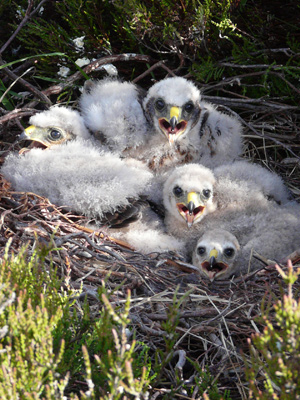Hen Harrier

The hen harrier is a scarce breeding species in Scotland that has been the subject of a considerable amount of interest over the past 25 years over concerns about its status, conservation, impact on grouse-moors and level of persecution. It is essentially an open country species, in the breeding season showing a close affinity to heather moorland and young forestry plantations with heather ground vegetation in upland areas. It has a widespread but thin distribution, capable of breeding throughout Scotland wherever suitable habitat exists but with the exception of Shetland and Lewis & Harris, where the harriers primary vole prey are absent.
In former times it was a much commoner bird frequenting the moors, bogs and wastes but following the creation of sporting estates during the 19th century, especially those associated with grouse shooting, it was quickly exterminated in mainland Scotland (Watson 1977). Only on islands such as the Uists and Orkney, where grouse-moors were not viable, were tiny populations maintained. Two World Wars in the 20th century, the resulting reduction in gamekeepers and the creation of vast forest plantations in the uplands provided a comeback opportunity and the breeding population steadily increased, peaking around the start of the 21st century but falling since. The majority of pairs still occur in those regions where driven grouse shooting is not a feasible proposition, particularly the Uists, Orkney, mainland of Argyll and the west coast islands from Skye to Arran. Their absence on the grouse-moors of eastern Scotland and in the Borders indicate that illegal persecution in these areas is still a major problem (Fielding et al. 2011) and that gamekeepers’ attitudes to harriers and their contempt for the law that protects the birds has changed little over the past 200 years. Moreover, the evidence suggests that on grouse moors, raptor intolerance in the last 10 years has risen to a new level, in line with a greater intensity of management.

There have been four national surveys of hen harriers in Scotland. The first in 1988/89 estimated a breeding population of 408-594 pairs (Bibby & Etheridge 1993). The second in 1998 located 436 pairs, 76% of UK breeding population (Sim et al. 2001). The third in 2004 revealed an increase to 633 pairs, 79% of the British population (Sim et al. 2007) and a 32% increase over the 1998 estimate. More surprisingly, this increase was confined solely to the west and far north and that the numbers of breeding pairs in the east and south where grouse-moors are prevalent had all declined. The fourth and most recent survey in 2010 (Hayhow et al. in press) recorded 505 territorial pairs, a 20% decline from the 2004 survey.
The hen harrier is a popular species amongst raptor enthusiasts and Scottish Raptor Study Group members are annually locating and monitoring about 250 territorial pairs, half of the 2010 estimated breeding population. However, despite this level of activity, the occupation of known breeding sites has been falling steadily since 2003, as has breeding success and mean brood size, all linked to the recent upsurge in persecution on UK grouse moors. This destruction is no longer confined to the breeding season but occurs throughout the year, with moorland communal roosts being targeted by some game preservers. Hen harriers face threats from many quarters: uncontrolled heather burning, overgrazing, the maturation of nesting forests and the proliferation of wind-farms in the uplands, all this in addition to the current high level of deliberate killing of adults and the destruction of nests by gamekeepers. However, SRSG members are strongly committed to monitoring the long-term effects of these land use changes but in particular the effect of illegal persecution on this iconic moorland species.
Brian Etheridge
References:
Bibby, C.J. and Etheridge, B. (1993). Status of the Hen Harrier Circus cyaneus in Scotland in 1988-89. Bird Study 40: 1-11.
Etheridge, B., Summers, R.W. and Green, R.E. (1997). The effects of illegal killing and destruction of nests by humans on the population dynamics of the hen harrier in Scotland. Journal of Applied Ecology 34: 1081-1105.
Fielding, A., Haworth, P., Whitfield, P., McLeod, D. and Riley, H. (2011). A Conservation Framework for Hen Harriers in the United Kingdom. JNCC Report No.441, Peterborough.
Hayhow, D.B., Eaton, M.A., Bladwell, S., Etheridge, B., Ewing, S. Ruddock, M., Saunders, R., Sharpe, C., Sim, I.M.W. & Stevenson, A. (in press). The status of the Hen Harrier, Circus cyaneus, in the UK and Isle of Man in 2010. Bird Study.
Sim, I.M.W., Gibbons, D.W., Bainbridge, I.P. & Mattingley, W.A. (2001). Status of Hen Harrier Circus cyaneus in the UK and the Isle of Man in 1998. Bird Study 48: 341-353.
Sim, I.M.W., Dillon, I.A., Eaton, M.A., Etheridge, B., Lindley, P., Riley, H., Saunders, R., Sharpe, C. & Tickner, M. (2007). Status of the Hen Harrier Circus cyaneus in the UK and the Isle of Man in 2004, and a comparison with the 1988/89 and 1998 surveys. Bird Study 54: 256-267.
Watson, D. (1977). The Hen Harrier. T. & A.D. Poyser, Berkhamsted.
Scottish Raptors• Honey-Buzzard• Red Kite• White-Tailed Eagle• Marsh Harrier
Hen Harrier• Goshawk• Sparrowhawk• Common Buzzard• Golden Eagle
Osprey• Kestrel• Merlin• Hobby• Peregrine Falcon• Barn Owl
Tawny Owl• Long-eared Owl• Short-eared Owl• Raven
